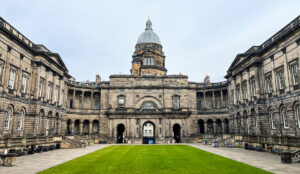
The magnificent Old College quadrangle at the University of Edinburgh
The University of Edinburgh has released a controversial report titled “Decolonised Transformations: Confronting the University of Edinburgh’s History and Legacies of Enslavement and Colonialism.” This document, commissioned in the wake of the death of George Floyd and the subsequent Black Lives Matter protests, aims to address historical and contemporary issues of racism at the institution. However, the report has drawn criticism for its lack of engagement with current grievances from staff and students regarding race.
The report primarily relies on administrative data concerning the ethnic and racial distributions of staff and students between 2018 and 2023. According to the demographic survey included, the proportion of white staff and students has decreased, while the percentage of Asian individuals has risen. Notably, the number of Black staff and students has remained stable at around 7 percent and 10 percent respectively. The report expresses concern over the stagnation of these figures, yet it fails to provide a clear rationale for what the expected numbers should be or why they are not being met.
Furthermore, the report does not substantiate claims of institutional barriers that may prevent the recruitment of a more diverse student body or staff. Instead, it leaves open the possibility that qualified individuals from these groups may simply choose not to attend or work at Edinburgh.
Questionable Methodology and Historical Context
To gauge experiences of racism, the report includes two questionnaires that measured staff and student perceptions. Critics note that these samples were small and self-selected, lacking statistical reliability. The questions posed in these questionnaires appear to be leading and subjective, focusing on perceptions rather than providing objective evidence of racism. The data presentation is also criticized for its opacity and inconclusiveness.
The report attempts to illuminate the university’s historical ties to racism and colonialism, but scholars argue that its analysis is insufficient. It claims to reveal hidden aspects of Enlightenment history, yet it does not provide new insights beyond what has already been extensively documented. The focus seems to shift between the 18th and early 19th centuries, conflating different historical periods and ideologies without adequate comparison to other universities in Europe and America.
“The argument rests on flawed abstract reasoning, not matters of fact,”
a critic noted, emphasizing the report’s tendency to equate historical ideas of race with contemporary social issues.
The historical section of the report includes a discussion of A. J. Balfour, a former chancellor of the university, suggesting a connection between his political views and the university’s current standing. Critics argue that such associations are misleading and fail to recognize the diversity of opinions among past and present members of the university community.
Implications of Moral Responsibility
At its core, the report presents a moral argument that groups racial and ethnic categories as unified entities, implying that individuals inherit the moral obligations or failures of their ancestors. This notion has drawn severe criticism for its implications, suggesting that individuals today should be held accountable for historical injustices.
This perspective runs counter to principles of individual moral responsibility, which are central to modern legal systems. The report’s argument, according to detractors, lacks a solid factual basis and instead relies on a moral framework that may not resonate with contemporary views on justice and accountability.
In summary, the University of Edinburgh’s race review raises significant questions about the relationship between historical context and present-day issues of race. With its contentious methodology and moral implications, the report has sparked a debate that extends beyond the campus, challenging how institutions confront their pasts while addressing current inequalities. As the university continues to engage with these complex issues, it remains to be seen how its findings will influence future policies and initiatives.







